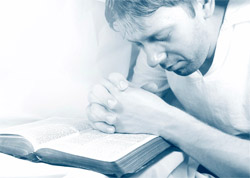General Bible Courses > Living by the Book > Surveying the Book
Chapter 1: The Pentateuch
Overview
IN THIS CHAPTER, you will discover:
Three divisions of the Old Testament.
Four great events and four great people of Genesis.
The historical background of the Exodus and Passover.
The reason Israel wandered in the wilderness for forty years.
AS A RESULT, you will be able to:
Describe the contents of the three divisions of the Old Testament.
Name the four patriarchs of the book of Genesis.
Know the way to God and how to please him.
Understand why God demands obedience and holiness in his people.
The Bible and the Old Testament
Reading: Talk Thru The Bible (TTB), pp. ix-xii; 1-2.
Key Words: Tanak, Septuagint
Key Verse: "He said to them, 'This is what I told you while I was still with you: Everything must be fulfilled that is written about me in the Law of Moses, the Prophets, and the Psalms.'" (Luke 24:44)
The Bible
What book has been a best seller for years... is a library in one volume... has over forty authors... knows no limits in time or culture... and contains drama, history, poetry, romance, prophecy, practical advice and much more? Of course, the answer is the Bible. Knowing this may not win you a trip to the Holy Land, but it does give you the key to a tremendous treasure.
Let's look at this marvelous book! The word Bible means "book" or "scroll." It is divided into two sections: the Old Testament (Covenant) with thirty-nine books and the New Testament (Covenant) with twenty-seven books. Although God made several covenants with his people, two predominate in Scripture. God made the old covenant with Israel on Mount Sinai through Moses his prophet. And Jesus instituted the new covenant with the church through shedding of his blood on the cross at Calvary. (See "Covenant" in the NIDB, pp. 237-38.)
God's revelation is always progressive, revealing more and more of his nature and character to his chosen people until the ultimate unveiling - Jesus Christ Incarnate. Jesus said, "Anyone who has seen me has seen the Father" (John 14:10).
The Old Testament
Many Christians neglect the Old Testament because of its size and difficulty. This is unfortunate since we cannot understand the New Testament without the foundation laid by the Old. The Hebrew Old Testament contains only twenty-four books and is divided into three sections: the Law, the Prophets, and the Writings. In Jesus' day, the Writings were often included with the Prophets which suggested a two-fold division - the Law and the Prophets (Matthew 7:12; Luke 16:16). The Hebrew Bible is commonly called the Tanak - and acronym for the three divisions (T=Torah; N=Neviim; K=Kethuvim).
The present order of the Old Testament books is based on a Greek translation called the Septuagint, often abbreviated LXX. This translation was produced in Alexandria, Egypt, about the third century B.C. Since Jews living outside Israel could no longer read Hebrew, it was necessary to translate the Hebrew Bible into Greek, the language of the day. Because the Septuagint was the Bible of the early Christian church, many Old Testament quotations in the New Testament are taken from it, rather than the Hebrew Bible. The Septuagint arranged the Old Testament into four divisions with thirty-nine books: Law (5), History (12), Poetry (5), and Prophecy (17).
Dr. Wilkinson, however, divides the Old Testament into three sections: Historical (17), Poetical (5), and Prophetical (17). The chart on page 2 of TTB will help you to understand better these divisions.
Key Concepts:
1. The two kinds of revelation are general and ______________________. [ix]
2. The three original languages of the Bible are Hebrew, Aramaic, and ___________________.[x]
3. Four evidences that indicate the divine origin of the Bible are: [x,xi]
4. The Hebrew Old Testament is divided into three sections: the Law, the ____________________, and the Writings. [1 ]
5. The prophetical books are divided into the major and the ___________________ prophets. [2]
6. List the following books under their proper heading: Job, 1 Samuel, Nahum, Malachi, Ecclesiastes, Isaiah, Ezra, Psalms, Exodus. [2]
Historical Poetical Prophets
7. Briefly describe the following Old Testament covenants. [New International Dictionary of the Bible (NIDB), 238]
Edenic -
Noachian -
Abrahamic -
Sinaitic -
Levitical -
Davidic -
Further study: Read the article "The Old Testament and the Christian" in the IBC, pp. 3-10.
Life Application: Have you read the thirty-nine books of the Old Testament? If Old Testament study overwhelms you, try reading a Key Chapter each day. Since these chapters capsulize the essence of each book, your reading will be more productive and, therefore, more enjoyable.
The Pentateuch and Genesis
Reading: Talk Thru the Bible, pp. 3-11.
Key Word: Beginnings.
Key Verses: "I will make you into a great nation and I will bless you; I will make your name great, and you will be a blessing. I will bless those who bless you, and whoever curses you I will curse; and all peoples on earth will be blessed through you" (Gen. 12:2-3).
Key Chapter: Genesis 15.
The Pentateuch
Pentateuch refers to the first five books of the Old Testament. These books are also called the Law, the Torah (the Hebrew word for "Law"), and the Books of Moses. The Pentateuch spans a time from the creation of the world to Israel\'s entrance into the Promised Land. Since we cannot fix a certain date to Creation, the length of this period is indefinite.
The Pentateuch primarily describes the origins of the nation of Israel, the sojourn in Egypt, the Exodus from Pharaoh\'s captivity, and the forty years of wandering in the wilderness of Sinai. Many of the Bible's most familiar characters appear here - Adam and Eve, Noah, Abraham and Sarah, Joseph, Moses, and Joshua. Their collective stories point to a unity of theme and purpose throughout the books. A historical and spiritual development progresses throughout the narrative. Page 3 of TTB charts the key concepts of the Pentateuch and summarizes the contents of each book.
Key Concepts:
Match the key ideas of the Pentateuch: [3]
Genesis A. Worship
Exodus B. Renewed Covenant
Leviticus C. Beginnings
Numbers D. Redemption
Deuteronomy E. Wandering
2. Moses viewed the Promised Land from (Mt.Sinai, Mt. Nebo). [4]
Genesis
The first part of the book of Genesis introduces the origin and spread of sin into the world, which culminates with a universal flood. The second section deals with Abraham and his descendants, who are used by God to bring salvation and blessing into the world. Genesis is a book about beginnings. Its Hebrew title "bereshith" comes from the first word of the book, meaning "in the beginning." The geographic location of the narrative fits into three settings: the Fertile Crescent, Israel, and Egypt. Locate each of these areas on the map on page 44 of TTB. An excellent map of the Fertile Crescent is found on page 352 of the NIDB.
The theme of Genesis involves God\'s choice of a nation which would, in turn, bless all other peoples. This nation, Israel, would enter in covenant with God. Two covenants are mentioned in Genesis-the first with Noah after the Flood and the second with Abraham. Through the Abrahamic covenant, Israel received three specific promises: 1) Iand, 2) nationhood, and 3) blessing.
The first messianic prophecy (proto-evangelium) in Scripture is found in 3:15 when Christ is referred to as the seed of woman. In addition, various types of Christ are found in Genesis. Adam stands as he, of the old creation while Christ is the head of the new. And Jesus is like Melchizedek, the righteous king and priest mentioned by the writ of Hebrews.
Key Concepts :
- The first-century historian, _____________________, credits Moses as being the author of Genesis. [6]
- Name three of the beginnings mentioned in Genesis. [7] __________________________, _____________________, ___________________________.
- The three great promises given to Abraham by God include _________________________, _______________________,
- and _____________________________.[8]
- ___________________________is the priest and king who is a type of Christ. [8]
- The four great events of Genesis are ________________________, ________________________, _____________________, and ________________________. [8-9]
- Man became separated from God at the__________________________________. [8-9]
- The four great people of Genesis are_______________________, _______________________, _____________________ and___________________________. [9]
Further Study: "Introduction to the Pentateuch," International Bible Commentary (IBC), pp. 78-83; "Genesis," New International Dictionary of the Bible (NIDB), pp. 380-82.
Life Application: Abraham is often called the "father of our faith." List the qualities in his character that you would like to imitate.
Exodus and Leviticus
Reading: Talk Thru the Bible pp 12-26.
Key Words: Redemption, Holiness
Key Verse: "Therefore say to the Israelites: 'I am the Lord, and I will bring you out from under the yoke of the Egyptians I will free you from being slaves to them and I will redeem you with an outstretched arm and with mighty acts of judgment'" (Ex. 6:6).
Key Chapters: Exodus 12-14, Leviticus 16.
Exodus
Exodus records Israel's birth as a nation. It opens by recalling Jacob's seventy descendants who have Joined Joseph in Egypt. By this time, the Israelites numbering two to three million people have lost favor with a new pharaoh. The title Exodus ("gone out") describes the book's key event The early date for the Exodus is about 1445 B.C. The book covers a time period from Jacob's arrival in Egypt, about 1875 B.C., to the erection of the tabernacle in the wilderness, about 1445 B.C. The author of Exodus is clearly an eyewitness to its events as well as being intimately acquainted with both Egypt and the Sinai wilderness.
Two basic themes run throughout the book: redemption (portrayed in the Passover) and deliverance (portrayed in the Exodus). Both redemption and deliverance are accomplished by the power of God and through the shedding of blood. The nation Israel is to establish Gods rule on earth but obedience is necessary for her to become a redeemed and sanctified people of God. Even as the Cross is the central event of the New Testament the Exodus is the central event of the Old Testament.
The core of God's revelation on Mount Sinai is the Ten Commandments or Decalogue (see "Commandments, Ten'" NIDB, pp. 228-230). The first five commandments concern Israel's duty to God while the last five concern their duty to their fellow man. The Decalogue has served as the basis for civil and moral law in all Christian societies. Yet the Ten Commandments, for all their greatness are unable to change the human heart. Even while Moses is on the mountain communing with God, the people below are making and worshipping a golden calf.
Key Concepts:
- Christ and Moses share the titles of prophet, ___________________ , and king. [14]
- Other than Moses, give three types or portraits of Christ found in Exodus. [14-15]
- When the Israelites left Egypt, God guided them by a pillar of ______________________. [15]
- The _________________________ lamb was a type of Jesus, the Lamb of God. [15]
- God gave Moses the Ten Commandments on Mount ____________________. [16]
- On the mountain Moses received the moral, civil, and ______________________ law from God. [16]
- Name three of the ten plagues. [16-17] 8. The ________________________ commandment prohibits adultery, thus preserving the sanctity of marriage. [NIDB, 230]
Leviticus
Leviticus continues the story of Israel, focusing on her worship and walk as a nation. Its events occur over one short month at the foot of Mount Sinai. The theme of Leviticus is holiness. The holy God can be approached only through sacrifice and the mediation of priests. Sanctification and obedience are necessary to maintain Israel's relationship to God. A "how to" guide for worship, laws and priestly behavior, Leviticus depicts the cleansing of the nation and the consecration of the people to the service of God.
The seven feasts of Israel provide a further portrait of Christ's ministry. The chart on page 43 of TTB shows the relationship between them. Although the rules and regulations of Leviticus may seem outmoded and of little value for the Christian life, much spiritual truth is revealed in them. Fellowship with God and pardon for guilt are especially emphasized.
Key Concepts:
- What statement (repeated 56 times in the book) suggests that Moses is the author of Leviticus? [21]
- Name three of the five offerings that show aspects of Christ's ministry.____________________, _____________________, _______________________. [22]
- Which feasts point to the coming of the Holy Spirit after Christ's Ascension? [22]
- The two kinds of holiness called for in Leviticus are ____________________ and _____________________. [23]
- ______________________ was the most important single day in the year for all of Israel. Why? _______________________________________________________________________. [22]
- To be holy means to be set apart or __________________________ unto God. [23]
Further Study: "Exodus"; "Exodus, Book of," NIDB, pp. 332-35; "Leviticus," NIDB, p. 593.
Life Application: Reflect on the relevance of the Passover Lamb for your Christian life (see note on "Lamb" in the NIVTSB, p. 1159). How has the blood of our Lamb, Jesus Christ, brought you spiritual life?
Numbers and Deuteronomy
Reading: Talk Thru the Bible, pp. 27-45.
Key Words: Wanderings, Covenant.
Key Verses: "And now, O Israel, what does the Lord your God askof you but to fear the Lord your God, to walk in all his ways, to love him, to serve the Lord your God with all your heart and with all your soul, and to observe the Lord's commands and decrees that I am giving you today for your own good?" (Deut. 10:12-13).
Key Chapters: Numbers 14, Deuteronomy 27.
Numbers
Either "Wilderness Wanderings" or "Divine Discipline" would be an appropriate summary for the book of Numbers, since the wilderness experience of Israel provides the subject for this important account. It receives its name, however, from the census (taken twice) which numbered the Israelites at over two and one-half million people. That God could provide for this multitude in such a desolate area is in itself a great miracle. Three distinct places provide the book's setting: Mount Sinai, the area around Kadesh Barnea, and, the plains of Moab.
Although the people are often faithless, God remains faithful to his covenant promises. Numbers, nonetheless, has a tragic theme, which shows the consequence of Israel's unbelief and disobedience. The first generation is doomed to die in the wilderness, and the second generation is called to trust God before they can possess the Promised Land.
Numbers is a book about divine discipline, which recounts Israel's testing and maturation. The wilderness is Israel's "school of hard knocks." Her wanderings teach an important lesson about biblical faith. Paul ( 1 Cor. 10: 1-13) and the writer of Hebrews (3 :7 -4 :6) both use the example of Israel in the wilderness to warn believers against self-indulgence, immorality, and unbelief.
At Kadesh, Israel's unbelief erupts as murmuring against God. Ten of the twelve spies sent out to Canaan return with a negative report. The rebellion at Kadesh is the turning point of the book. This unbelieving generation is sentenced to spend one year in the wilderness for every day spent by the spies in Canaan. Joshua and Caleb are the spies allowed to enter Canaan. When this unbelieving genera a new generation is prepared by God to enter the land. This book of wanderings displays God's kindness and severity. In addition, it teaches about the truth and dependence he requires of his people.
Key Concepts:
- How long did the new generation stay on the plains of Moab preparing to enter the Promised Land? [27] _________________.
- What is the symbol for Christ's crucifixion in Numbers? [29] _____________________________________________________.
- Paul in 1 Corinthians 10:4 wrote that the spiritual Rock in the wilderness was ____________________________. [29]
- The ___________________________ in the wilderness pictures the Bread of Life who came down from heaven. [29]
- The heathen prophet ____________________________ prophesied of the rulership of Christ. [29-30]
- Why did God decide on 40 years for the Israelites to wander in the wilderness? [31] __________________________________.
Deuteronomy
While the name Deuteronomy means "The Second Law," the book does not simply repeat the law given to Moses on Mount Sinai Instead, an adaptation and expansion of the first law is given to the Israelites. Unlike Leviticus, Deuteronomy is directed toward the people rather than the priests. Here is the generation that has survived the wilderness wanderings - poised to enter the Promised Land. Their great leader Moses, realizing that he will soon be leaving them, delivers three farewell sermons.
"Beware lest you forget" is the theme of the book. The Israelites are to remember two things as they enter Canaan: God will be the source of their prosperity, and God will discipline them if they disobey him.
God is always faithful to his covenant. Deuteronomy is a covenant renewal document that resembles an ancient Near Eastern treaty. All five elements of such treaties can be found in the book. That God would initiate such an agreement shows his commitment to his people.
But Israel's new generation must similarly choose to be faithful. The book, while highlighting God's love (a subject crucial to Israel's understanding of him), emphasizes the importance of choice. God's people are encouraged to choose life rather than death.
Key Concepts:
- Moses' successor, __________________________, probably wrote his obituary. [38]
- When was the book written and for what purpose? _________________________________________________________[38]
- The format of the book parallels other Near Eastern ­________________________________. [38]
- Genesis through Numbers portray God's ways, but Deuteronomy reveals God's ____________________________.[39]
- How do we know that Deuteronomy was perhaps Christ's favorite book? [39] ______________________________.
- The three categories of the Law are the testimonies, the ___________________________, and the ordinances. [40]
Further Study: "Numbers, Book of," NIDB, pp. 713-14; "Deuteronomy," NIDB, pp. 269-71.
Life Application: Have you ever had a wilderness experience in your Christian life? What was the reason(s) for your wanderings? How did God finally bring you into the "Promised Land?"
Take the quiz
Quiz Instructions
Review Questions
1. True or False. The Old Testament has twenty-seven books while the New Testament has thirty-nine books.
True
False
2. The word "Bible" means ___________________________________or "scroll."
Book
Word
3. True or False. The three languages in which the Bible was written are Latin, Aramaic, and Greek.
True
False
4. The three divisions of the Hebrew Old Testament are the Law, the _________________________and the Writings.
Prophets
Authors
5. The present order of the Old Testament follows the Greek translation called the _______________________________.
Balaam
Septuagint
6. Pentateuch refers to the first __________________________ books of the Bible.
Five
Six
7. Genesis 1-11 culminates with a universal ________________________.
Tower of Babel
Flood
8. ___________________ is traditionally named as the author of the Pentateuch.
Moses
Joshua
9. God made a covenant with______________________, promising him land, descendants, and manifold blessings.
Abraham
Isaac
10. Jacob's favorite son _______________________ was sold into bondage in Egypt.
Benjamin
Joseph
11. True or False. The early date for Israel's departure from Egypt is approximately 1455 B.C.
True
False
12. The central event of the Old Testament was the ______________.
(a) Passover
(b) Exodus
13. At the _______________________, God spared the Israelites' firstborn because their doorposts were covered with the blood of lambs.
Passover
Yom Kipper
14. True or False. The theme of Leviticus is the love of God.
True
False
15. _________________________ the brother of Moses, was Israel's first high priest.
Aaron
Eli
16. Numbers records the __________________________ of Israel in the wilderness.
Wanderings
Sin
17. ________________ a diviner and prophet who enticed the Israelites into idolatry, still prophesied of the rulership of Christ.
Balaam
18. Joshua and ________________________ were the only spies allowed to enter Canaan.
Caleb
Aaron
19. Deuteronomy is a covenant renewal document that resembles a Near Eastern _________________.
(a) law code
(b) treaty
20. Moses appointed __________________________ as his successor to lead Israel.
Joshua
Aaron




